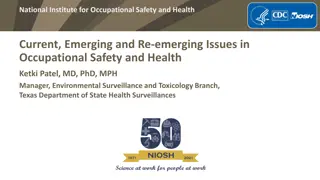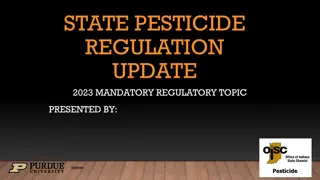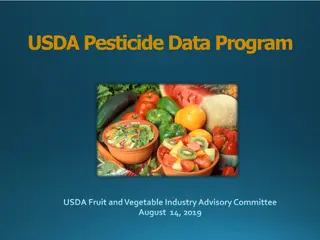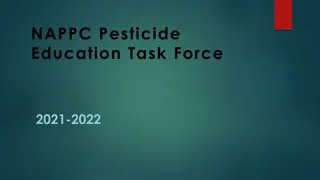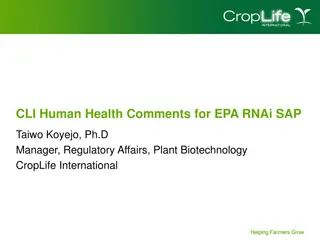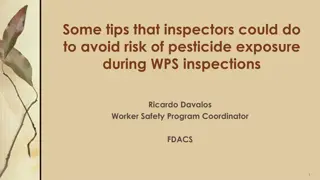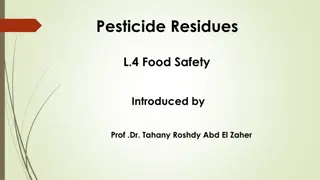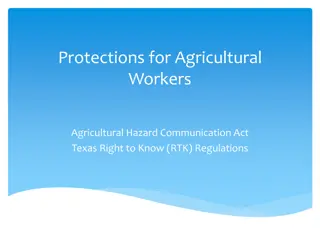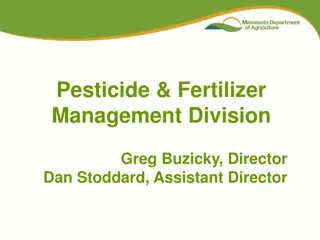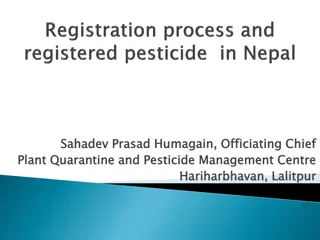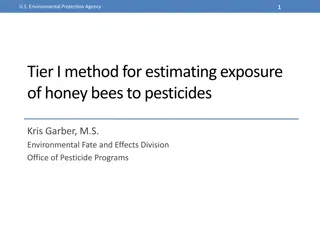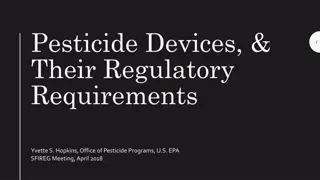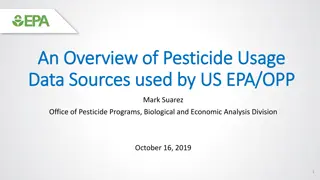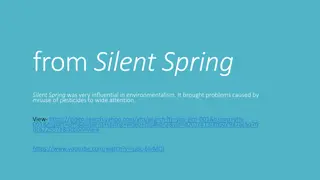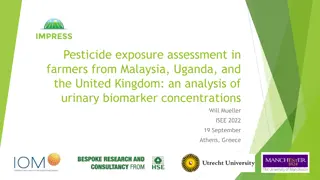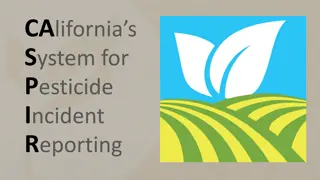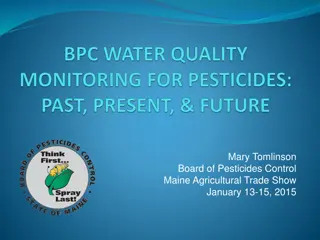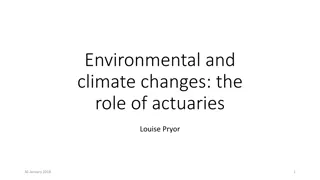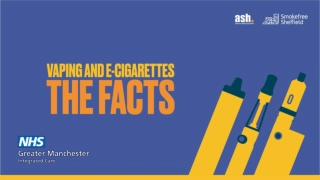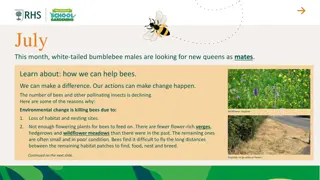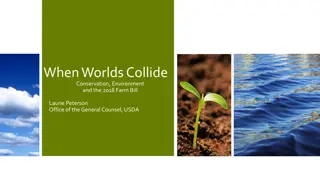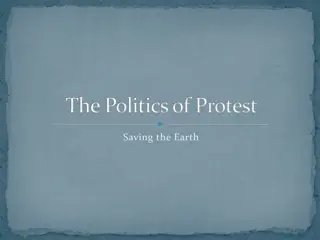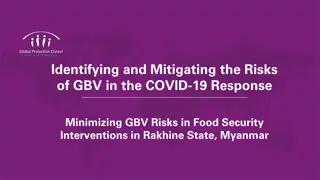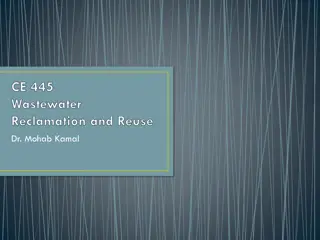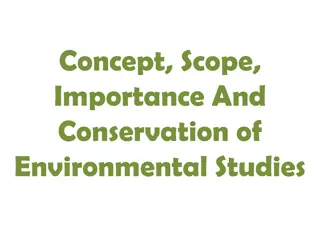Understanding Environmental Risks of RNAi Technology as a Pesticide
This presentation discusses the environmental considerations and risk assessments associated with RNAi technology as a pesticide, focusing on the unique challenges presented by dsRNA PIPs. Topics covered include ecological risk assessments, nontarget organism exposure, exposure assessments for PIP plant material and dsRNA, as well as the potential risks to various organisms such as birds, mammals, fish, invertebrates, plants, arthropods, and honey bees. The primary route of exposure is through the ingestion of dsRNA, emphasizing the importance of evaluating the impacts on different ecosystems and species.
Download Presentation

Please find below an Image/Link to download the presentation.
The content on the website is provided AS IS for your information and personal use only. It may not be sold, licensed, or shared on other websites without obtaining consent from the author. Download presentation by click this link. If you encounter any issues during the download, it is possible that the publisher has removed the file from their server.
E N D
Presentation Transcript
RNAi Technology as a Pesticide: Problem Formulation for Human Health and Ecological Risk Assessment Presentation to EPA Science Advisory Panel Arlington, VA, 28 January 2013 Environmental Considerations for PIP Expressed dsRNA Shannon Borges, Lead Biologist Biopesticides & Pollution Prevention Division Office of Pesticide Programs
PIP Ecological Risk Assessments Most PIPs that are currently registered are Bacillus thuringiensis (Bt) derived proteins Currently, a framework is in place to assess ecological risk based on experience with Bt-derived PIPs dsRNA PIPs may present unique challenges that have not yet been encountered for Bt-derived PIPs 2
Nontarget Risk Assessment for PIPs: Overall Approach EPA PIP Nontarget Organism Risk Assessment Environmental Fate and Distribution Nontarget Organism Effects 3
Exposure Assessment: Distribution of PIP Plant Material On Field Off Field Other terrestrial surfaces Expression in: - Stems - Leaves - Pollen - Seeds/fruits - Nectar? - Guttation water? Pollen Pollen Off-field plants Soil Stems, leaves, etc. Surface water bodies Stems, leaves, etc. Incorporation - Roots - Root exudates? Root exudates? 4
Exposure Assessment: Distribution of dsRNA Released from Plant Material Lysing of plant cells dsRNA (free in the environment) Terrestrial Environment -Soil -May degrade/persist -May move offsite Aquatic Environment -Water column and/or sediment -May degrade/persist -May move with current 5
Nontarget Organism Exposure Taxa evaluated: Birds Wild mammals Freshwater and marine/estuarine fish and invertebrates Nontarget plants Nontarget arthropods Honey bees 6
Nontarget Organism Exposure: Exposure to PIP Plant Material Primary route of exposure expected to be ingestion of dsRNA, most likely by ingestion of PIP plant material Ingestion by invertebrates as food Incidental ingestion by invertebrates and vertebrates on/in other food items Ingestion in water: intentional or incidental Pollen Secondary exposure to predators, parasites Stems, leaves, seeds, fruits Consumption by vertebrates and invertebrates May be incidental depending on organism, location in environment, and degree of decay Roots Nectar? Guttation water? Root exudates? 7
Nontarget Organism Exposure: Exposure to dsRNA Released from Plant Material Lysing of plant cells dsRNA (free in the environment) Terrestrial Environment -Incidental/intentional ingestion (soil) -Exposure via integument Aquatic Environment -Incidental/intentional ingestion (sediment, water - including drinking) -Exposure via integument 8
Factors Affecting Exposure Level and Duration Expression level Crop plant biology and cultural practices Persistence Degradation of dsRNA within plant tissues Environmental conditions Environmental concentration Barriers to exposure Nontarget exposure 9
Fate and Nontarget Effects: EPAs Current Testing Framework for PIPs Tier I: High dose testing using artificial source of the PIP Tier II: Lower dose testing using PIP plant material Tier III: Long term laboratory and semi-field studies Tier IV: Field studies 10
Current Testing Requirements Based on Bt-Derived PIPs Tier I/II Testing: Environmental Fate: Plant expression Soil degradation Nontarget Effects Toxicity Testing: Wild mammal Freshwater invertebrate Avian oral Estuarine/Marine animal Avian dietary Honey bee (adult and larvae) Monarch butterfly* Freshwater fish Nontarget arthropod Non-arthropod invertebrate Nontarget plant Synergism** Tier IV Testing: Multi-year soil degradation Nontarget arthropod field studies * Lepidopteran active PIPs with expression in pollen ** Combination PIPs 11
dsRNA - Unique Challenges Uncertain specificity Other potential unintended effects Secondary effects of RNAi Latent effects Effects on life stages not included in testing Chronic effects Unknown environmental fate and persistence 12
Information Needs Exposure Fate and persistence of dsRNA Additional testing/other information Exposure routes and barriers Effects Specificity and other unintended effects of dsRNA How unintended effects may be addressed within current testing framework Alternative approaches to testing 13


